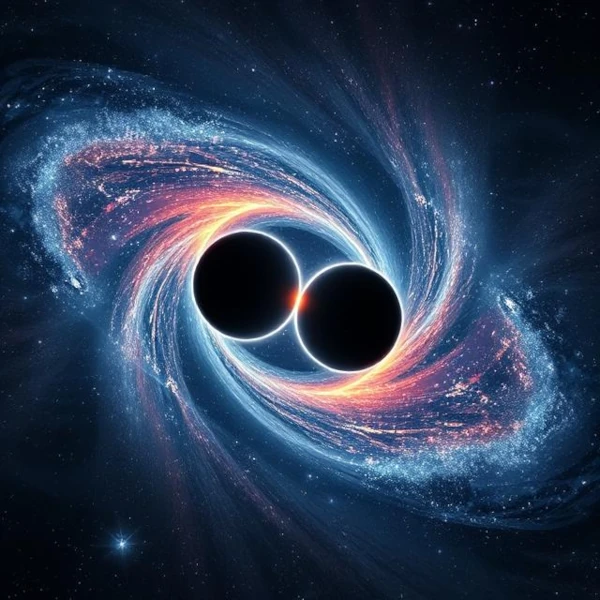
A wave is a physical phenomenon involving the propagation of a disturbance through a material medium or a vacuum. It carries energy without net transport of matter. Several types of waves are distinguished according to their nature and propagation medium.
Mechanical waves, such as water waves or seismic waves, require a material medium (liquid, solid, gas). They are characterized by an amplitude, a wavelength \(\lambda\), a frequency \(f\), and a propagation speed \(v\), related by the fundamental equation \(v = \lambda f\).
Electromagnetic waves, such as visible light, radio waves, or X-rays, are coupled oscillations of the electric and magnetic fields, capable of propagating through a vacuum at the speed of light \(c \approx 3 \times 10^8\ \text{m/s}\).
Finally, gravitational waves belong to another category: they are not vibrations of a material medium but perturbations of the metric of spacetime itself. They differ from classical waves because they directly alter the measured distances between free objects.
N.B.:
A physical phenomenon is an observable and measurable event that can be described by the laws of physics, such as the fall of bodies, the propagation of a wave, or the emission of light. In the case of gravitational waves, it is the perturbation of spacetime itself, not a vibration of a material medium.
Gravitational waves are ripples in spacetime (cosmic fabric), predicted in 1916 by Albert Einstein (1879-1955) as part of general relativity (1915). They propagate at the speed of light \((c)\) and result from extremely energetic cosmic events, such as the merger of two black holes or neutron stars.
Gravitational waves provide a new way to probe the Universe. Unlike electromagnetic waves (radio, visible light, X-rays), they are not absorbed by matter. This allows the study of previously inaccessible regions, such as the interior of supernovae or the first seconds after the Big Bang.
On September 14, 2015, the LIGO interferometer directly observed a gravitational wave for the first time, resulting from the merger of two black holes located 1.3 billion light-years away. The measured signal corresponded to a relative length variation \(\Delta L / L \approx 10^{-21}\), equivalent to detecting a deformation smaller than the diameter of a proton over 4 km arms.
The sensitivity of gravitational wave detectors like LIGO and Virgo relies on laser interferometry. The principle is to compare with extreme precision the length of two perpendicular 4 km arms using a laser beam split in two and recombined after reflection on mirrors suspended as pendulums, in an ultra-high vacuum, which acts as a natural mechanical filter.
When a gravitational wave passes through the instrument, it causes a relative length variation \(\Delta L / L \approx 10^{-21}\), or an absolute variation \(\Delta L \approx 4 \times 10^{-18}\ \text{m}\). This value is about a hundred times smaller than the diameter of a proton (\(\sim 10^{-15}\ \text{m}\)).
To achieve such precision, several techniques are used:
Thanks to these combined methods, interferometers achieve unprecedented precision, capable of detecting a variation smaller than the diameter of a proton over a macroscopic distance of several kilometers.
| Date | Event | Source | Distance |
|---|---|---|---|
| September 14, 2015 | GW150914 | Merger of two black holes (36 and 29 solar masses) | 1.3 billion light-years |
| August 17, 2017 | GW170817 | Merger of two neutron stars | 130 million light-years |
| May 21, 2019 | GW190521 | Merger of two massive black holes (85 and 66 solar masses) | 7 billion light-years |
Sources: LIGO Scientific Collaboration – GW150914, Virgo Collaboration, LIGO Scientific Collaboration – GW190521.
Although the scientific community now considers the detection of gravitational waves as established, some critical studies have raised doubts, particularly during the initial announcements. These studies do not necessarily challenge general relativity but question the robustness of data analysis.
For example, in 2016, an independent team (J. Creswell et al., University of Copenhagen) published an analysis highlighting unexpected correlations in LIGO detector noise. According to their findings, the GW150914 signal, attributed to a black hole merger, could exhibit signatures compatible with instrumental artifacts rather than a genuine gravitational wave.
These criticisms mainly concern:
In response to these objections, the LIGO–Virgo collaboration strengthened its cross-validation methods, published detailed analyses, and confirmed several other independent events (such as GW170817, accompanied by an electromagnetic signal observed by telescopes). This multi-messenger concordance provides strong validation of the detections.
Thus, although some critical voices persist, the accumulation of consistent and diverse observations makes an exclusively instrumental explanation of the recorded signals extremely unlikely.